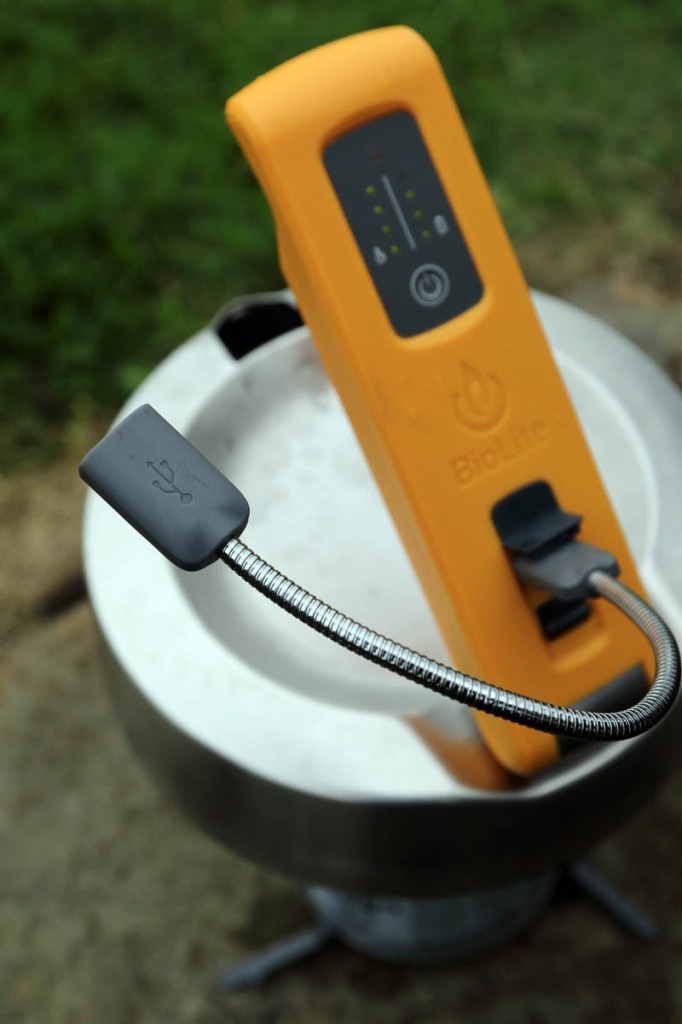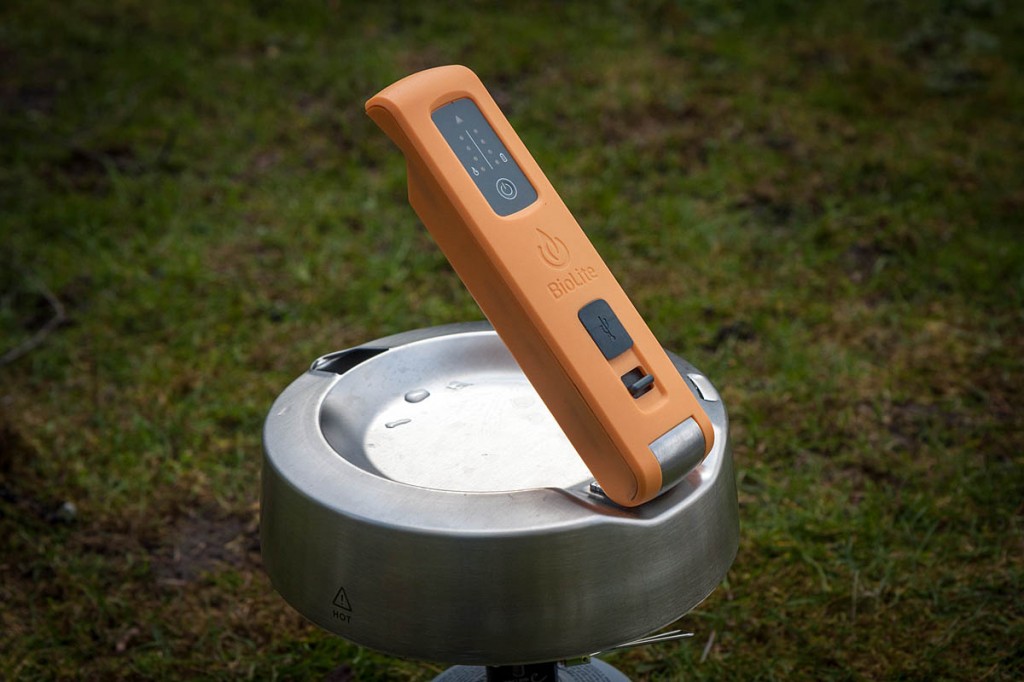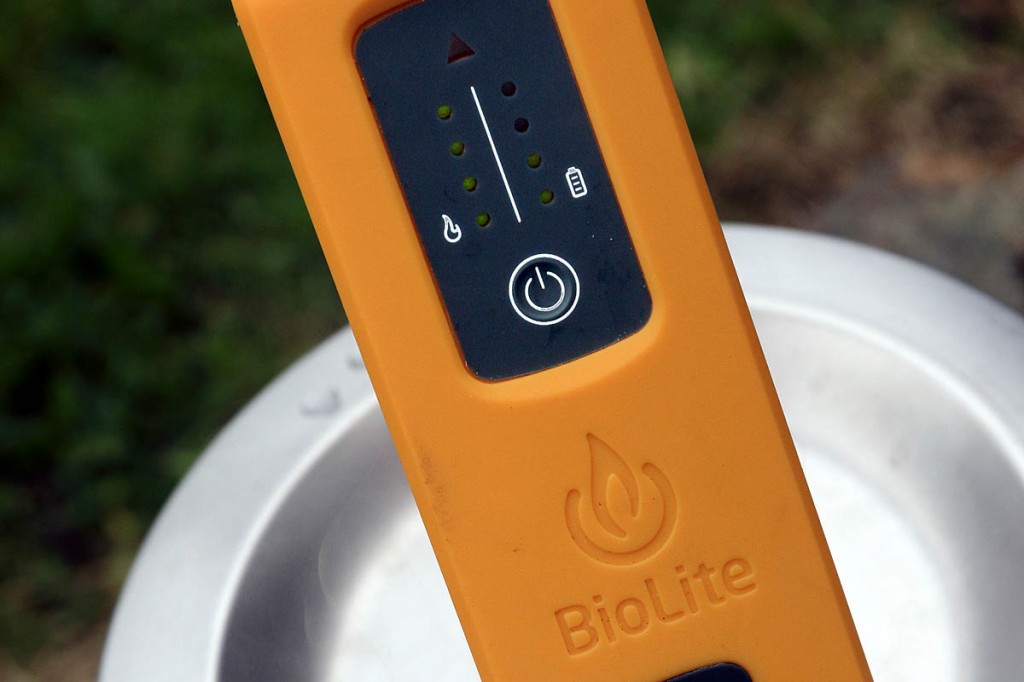Price: £139.95
Weight: 938g (including USB extender lead)
Power output: 10W (5V, 2A)
Country of manufacture: China
Few of us these days head into the outdoors without some kind of electronic gadget reliant on battery power.
It might be a smartphone, most of which seem to use up a full battery in a day or less, a tablet, or a GPS device. And some of these can be vital to safety and if not, we have become increasingly needy in our desire to stay connected to the wider world.
The trouble is, there are no convenient power sockets on hill tops or the wilderness.
Biolite thinks it might have the solution in its quirky KettleCharge.
As the name implies, this is a kettle that will charge up your gadget while you boil water for that much needed hot drink.
The KettleCharge is a 750ml capacity vessel with an orange fold-down handle that has a USB output socket and a set of LEDs to tell you what it’s doing.
We would suggest this is not something you would consider for a lightweight expedition. The stainless steel and aluminium kettle is quite beefy and weighs not far off a kilogram with its supplied flexible metal USB extender cord, which has a male plug at one end to slot into the handle and a female one at the other end, which you plug your charger cord into.
The base is very solid and contains the important technology: a thermoelectric generator, for which we have to thank Thomas Johann Seebeck who, in 1821 discovered that a temperature difference between two different conductors causes an electrical voltage.
So when you placed your KettleCharge on a gas stove, the difference between the hot underside and the cooler upper conductor in the vessel produces the electrical charge which is then stored in a lithium iron phosphate battery in the handle.
So essentially, the KettleCharge uses the energy from your gas canister to produce enough electrical energy to give your smartphone or tablet a boost.
We tested the BioLite KettleCharge in a variety of situations using lightweight stoves as well as a domestic gas hob.
The handle has two sets of LEDs. The left bank indicates how much heat is being applied to the underside of the kettle and the right bank progressively lights when charge is being stored. Once you have at least two power lights lit, you can connect a device and start charging it.
The problem we encountered was, no matter how long we left the kettle on our stoves or hob, we couldn’t get the fourth LED to light. After 28 minutes boiling away on our stove, there were still only three lit, and that was with maximum heat indicated.
That’s a lot of precious, and expensive, butane and propane to burn – much longer than needed to bring the water in the kettle to the boil. The kettle also spits a little boiling water out of its spout while the water level is high, so care is needed.
After five minutes plugged into the kettle, our smartphone’s battery level had gone up by 3 per cent. We stopped boiling after 35 minutes, as the water was in any case getting to the minimum level, most of it having boiled away.
It took eight minutes on the stove for the second LED to light and the kettle being available to charge. The third LED came on after 15 minutes burning. Plugging our phone in after removing the kettle from the heat with three LEDs lit boosted it by 15 per cent, taking 29 minutes before the kettle’s stored charge was depleted.
Using the kettle on mains gas, which surprisingly was unable to heat the base as much as a butane-propane canister, we achieved a nine per cent increase in our phone’s battery after 10 minutes plugged into the kettle.
These charges were only achieved by boiling water for much longer than was necessary for our hot drinks, which means if you’re going to use the KettleCharge for a substantial boost to your electronics, you’re going to use quite a bit of gas. The kettle can’t be used over large open fires, as flames mustn’t be allowed to lick over the sides of the vessel, but if you could maintain a compact open fire from available materials, this would be a much cheaper option.
The KettleCharge has warnings in case the heat level becomes too high, and also one if the water level inside drops too low, as this could damage the kettle’s electronics.
On a purely practical level, the KettleCharge doesn’t discharge its water too well. Pouring the hot water from the spout produced a large amount of dribbling which missed the target cup.
BioLite’s KettleCharge is a great idea – getting electrical power while boiling water that you’d be heating anyway. But it takes too long on the stove to be economical.
We would recommend plugging in your device as early as you can to get the maximum charge while the kettle is working. It will certainly boost an almost dead phone enough to use it for a little while.
It will also appeal more to valley campers who have access to a good supply of gas rather than a lightweight backpacker who is carrying only one or two precious gas canisters.
The other drawback is the price of the unit itself. The KettleCharge is pricey, though it is well made and very solid feeling and a neat design.
Performance: 35/70
Design: 7/10
Quality: 9/10
Value for money: 4/10
Total score: 55/100


